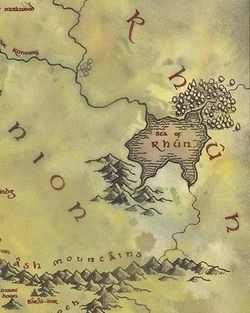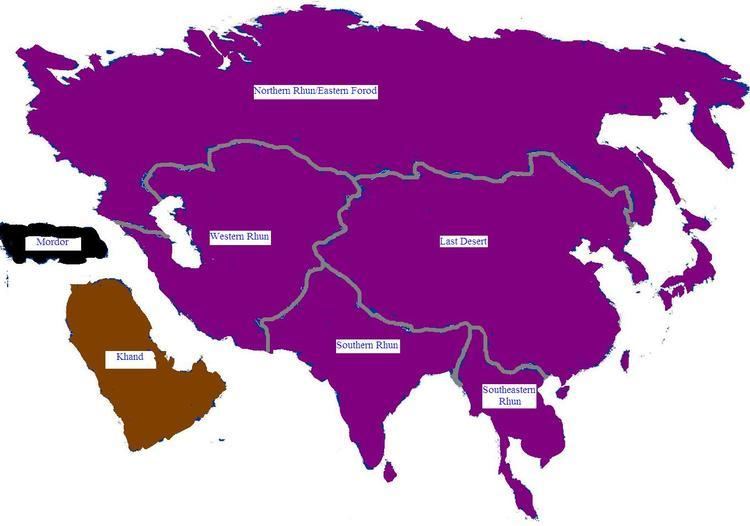 | ||
Other name(s) the East, the Eastlands Type Vast lands of the further East of Middle-earth Location East of Wilderland and Mordor | ||
In the fictional world of Middle-earth created by J. R. R. Tolkien, Rhûn ([r̥uːːn]) was a large region of eastern Middle-earth. Rhûn (which is also the Elvish word for "east") was the name used for all lands lying east of Wilderland, around and beyond the inland Sea of Rhûn, from where came many attacks on Gondor and its allies during the Third Age of Middle-earth.
Contents

The power of rh n and harad
Literature

Almost nothing can be known of the lands beyond the Sea of Rhûn from Tolkien's written work, though it is vaguely described in The Fellowship of the Ring as a realm of "wide uncharted lands, nameless plains, and forests unexplored". The wizard Gandalf had never explored these lands, and though Aragorn is said to have travelled to them, there is no report of what he did while there.
Rhûn's ancient geography can be gleaned a little from The Silmarillion; throughout most of the First Age the vast Sea of Helcar was located there and beyond that the Orocarni ('red mountains'). Somewhere in the east, too, lay Cuiviénen and Hildórien, where Elves and Men first awoke: all the Children of Ilúvatar could trace their ancestries back to the eastward regions of Middle-earth.
Rhûn was the domain of the Easterlings, Men of Darkness who were ready to follow both the Dark Lords and fought as their allies in war. These lands were also peopled by lost Elves, Avari and Úmanyar, and by four of the seven clans of the Dwarves.
During the Third Age, Rhûn was visited by three Wizards: Saruman, Alatar and Pallando, and though Saruman returned into the west, the two Blue Wizards remained or went to the south to the lands of Khand and beyond. Sauron himself journeyed into the eastward lands, hiding there from the White Council during the centuries known in the west as the Watchful Peace. He seems to have had a second fortress somewhere in Rhûn where he dwelt during that time and earlier during the Second Age, as his original realms were in the East, not in Mordor. This eastern abode of the Dark Lord is briefly noted in The Silmarillion as a place which he surrounded with fire.
Dorwinion lay on the west side of the Sea of Rhûn. The Easterlings of the Balchoth and Wainriders mostly occupied the lands to the far east of the Sea of Rhûn, where they lived on the nomadic steppes.
In other works
Cartographer Karen Wynn Fonstad, who created The Atlas of Middle-earth, speculated that the Sea of Rhûn may have been a body of salt water.
Guy Gavriel Kay's fictional land Tigana has been seen as having many references to Tolkien's Middle-earth. Among other similar names, a land called Run occurs in Kay's novels.
